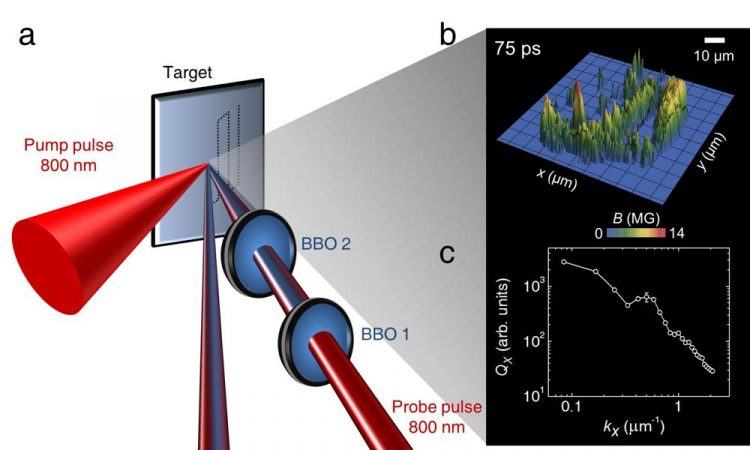Table top plasma gets wind of solar turbulence

(a) A pump pulse creates the plasma on a solid while a probe pulse monitors the time evolution. The top panel in b shows the spatially randomized magnetic field in the plasma while the figure at the bottom shows the power spectrum of the magnetic field (magnetic energy density variation of with inverse of spatial length. The curve indicates magnetic turbulence in the plasma and mimics that from the solar wind. Credit: G. Chatterjee et al., Nature Communications, 10.1038/NCOMMS15970
Turbulence is everywhere- from tea cups to tokomaks and from water jets to weather systems, it is something we all see and experience. Yet, even after centuries of serious scientific study, fluid turbulence is still not properly understood and remains “Interesting. Vexing. Longstanding. Unsolved.”[1]. While it is difficult to define turbulence simply, it has many recognizable features, the most common being the fluctuations in parameters like velocity and pressure, indicating randomization of the flow [2].
By the way, turbulence is not all bad and destructive as you might feel when tossed around on a flight during bad weather. One good feature is that it enables much faster mixing than possible only with normal, slow diffusion. For instance, the sugar you added in your cup of tea this morning would have taken hours and days to disperse but for your stirring which caused your tea to become turbulent.
As you have surely noticed, you stirred the tea in a large circle, but the swirling spread to smaller and smaller lengths and eventually, the mixing occurred at the molecular level. The end result? Even the smallest drop of tea is as sweet as a large gulp! Turbulence also helps in mixing fuel and oxygen for efficient combustion in engines.
Much of our universe is of course not an ordinary fluid but consists of highly ionized gas known as plasma and this plasma can often be extremely hot and swirling at unimaginable speeds. Turbulence in a plasma is much more complex than that in neutral hydrodynamic fluids.
In a charged plasma environment, the negatively charged, light electrons and positive heavy ions respond at vastly different length and time scales. The motion of these charged species is governed by electromagnetic forces and the current flow through the charge particle dynamics leads to magnetic field generation. Therefore the randomness of magnetic fields often mimics the fluid turbulence in plasmas.
The team of scientists leading this new study, at the Tata Institute of Fundamental Research, Mumbai, Institute of Plasma Research, Gandhinagar (both in India) and at the Instituto Superior Tecnico, Universidade de Lisboa, Portugal find that the turbulence in the magnetic field is initially driven by the electrons (at a trillionth of a second) and the ions step in and take over at longer times.
This is the first time such a 'relay race' involving two different species has been glimpsed. Further, these lab observations have an uncanny resemblance to the satellite data on the magnetic field spectra measured for turbulent astrophysical plasmas in the solar wind, solar photosphere and earth's magnetosheath. Although in the laser experiment the electrons in the plasma get energised initially, the ion dominant response that kicks in at later times shows spectral features similar to those in the astro systems.
These experiments thus establish clear connections between the two scenarios, even though the driver of turbulence in the lab plasma is very different from that in the astrophysical system.
Now that we have got wind of solar turbulence on a table top, can we use lab experiments to turn the tables on the intractable problem of turbulence? Well, that may still be a long way off but it is a tantalising prospect that reliable measurements in the lab might make us better and better at peeking into turbulent stellar scenarios.
And that should set off stars in our eyes!
###
References:
[1] L.P. Kadanoff, Physics Today, Vol. 48, no.9, p11 (1995)
[2] K.R. Sreenivasan, McGraw-Hill Encyclopaedia of Science and Technology, 10th Edn., Vol. 18, p725.
[3] G. Chatterjee et al., Nature Communications, 10.1038/NCOMMS15970 (2017)
Media Contact
All latest news from the category: Physics and Astronomy
This area deals with the fundamental laws and building blocks of nature and how they interact, the properties and the behavior of matter, and research into space and time and their structures.
innovations-report provides in-depth reports and articles on subjects such as astrophysics, laser technologies, nuclear, quantum, particle and solid-state physics, nanotechnologies, planetary research and findings (Mars, Venus) and developments related to the Hubble Telescope.
Newest articles

NASA: Mystery of life’s handedness deepens
The mystery of why life uses molecules with specific orientations has deepened with a NASA-funded discovery that RNA — a key molecule thought to have potentially held the instructions for…

What are the effects of historic lithium mining on water quality?
Study reveals low levels of common contaminants but high levels of other elements in waters associated with an abandoned lithium mine. Lithium ore and mining waste from a historic lithium…

Quantum-inspired design boosts efficiency of heat-to-electricity conversion
Rice engineers take unconventional route to improving thermophotovoltaic systems. Researchers at Rice University have found a new way to improve a key element of thermophotovoltaic (TPV) systems, which convert heat…



